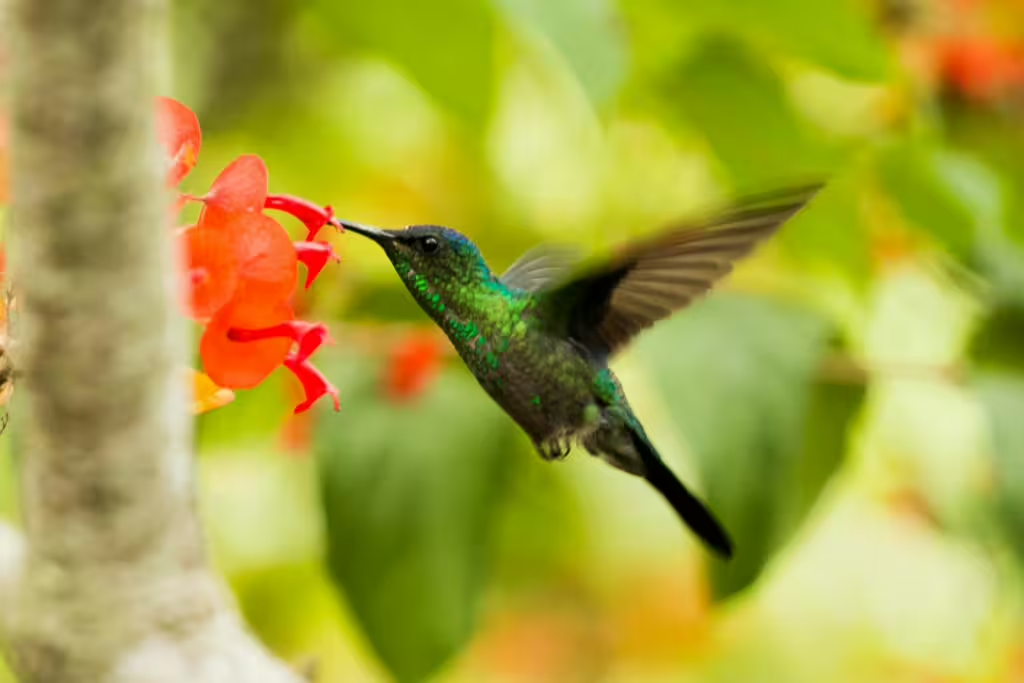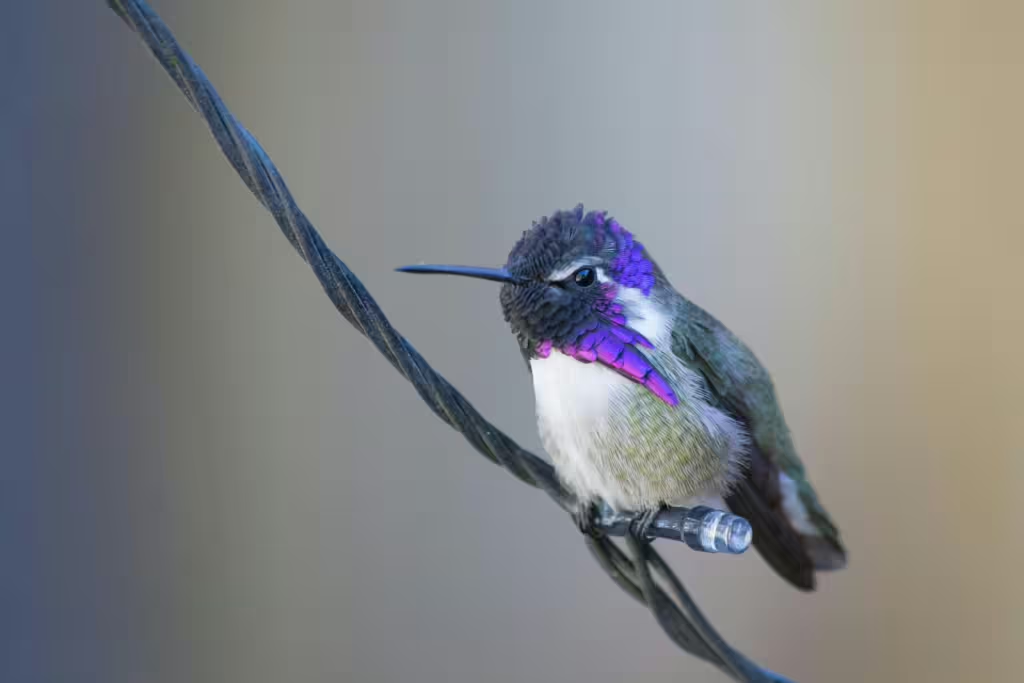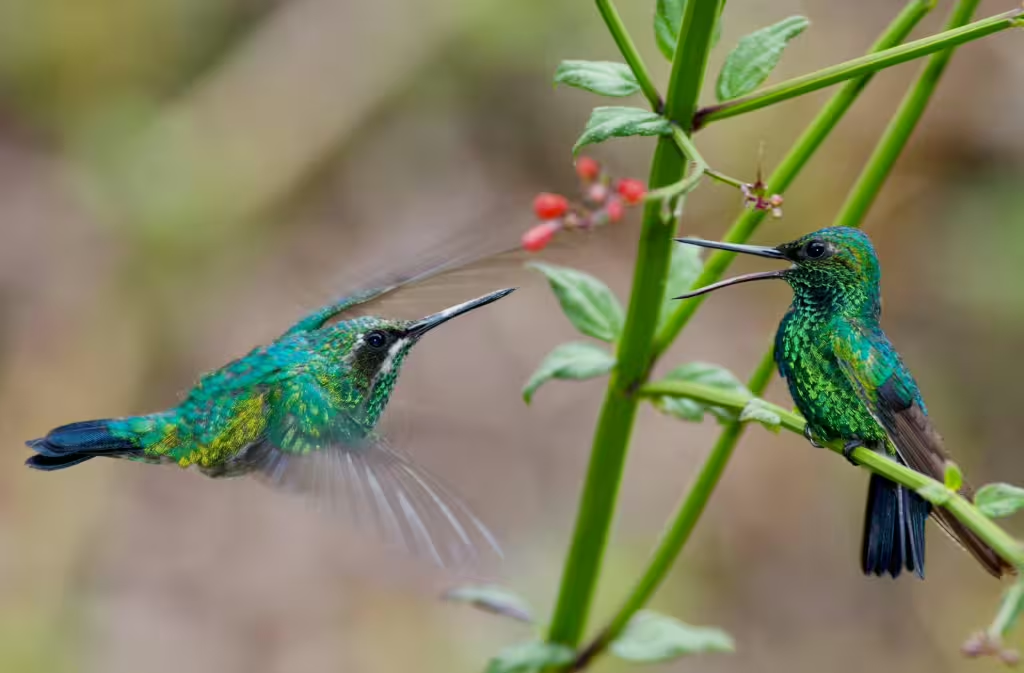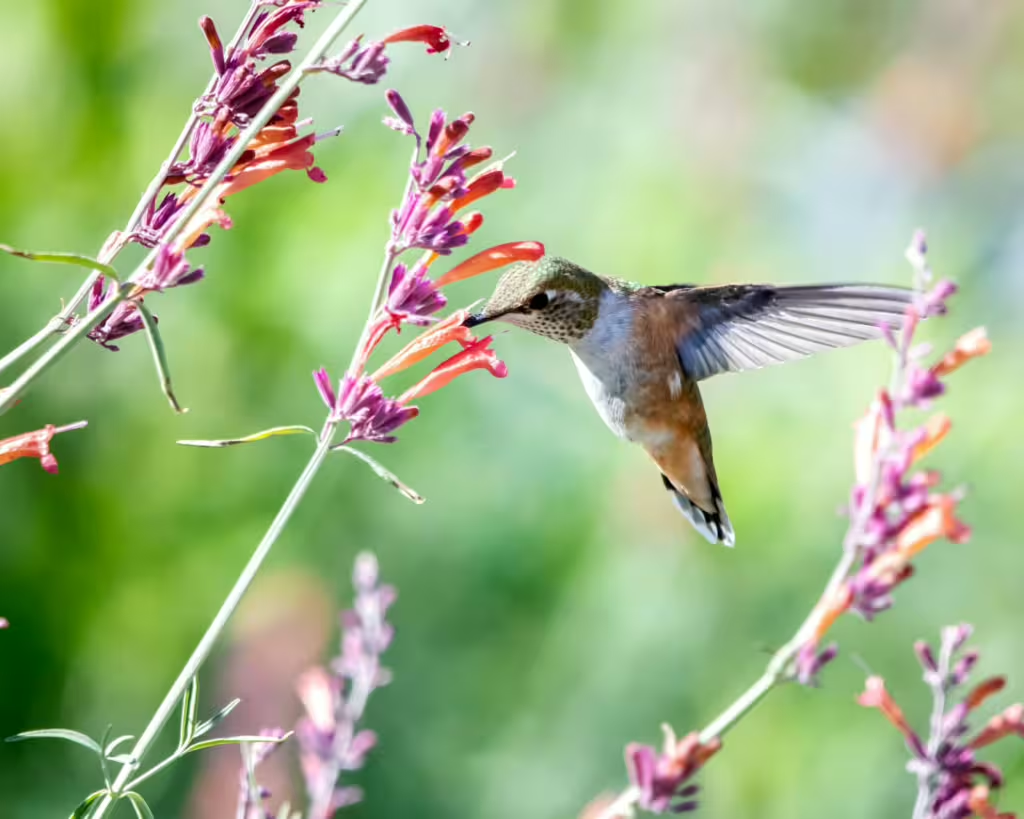In the lush, vibrant ecosystems of the rainforest, a shimmering shape flutters among the flowers. In this primeval place, life thrives in a dynamic and interconnected web, yet these small, seemingly innocuous shapes are so important to the continuation of life in this place, that many would scarcely believe it to be true. So powerful is the iridescent little hummingbird that it is basically a miracle of nature.
The colorful plumage and captivating movement of this tiny bird has attracted the attention of observers for centuries. The hummingbird is possessed of incredible speed, agility, and a mesmerizing beauty that is almost beyond compare. In many ways, these magnificent avian marvels are a symbol of the rainforest itself—bright, vibrant, full of life, and necessary for the continued survival of their entire ecosystem; and many more besides.
Rainforests, particularly those located in the tropics, serve as the heart of regional biodiversity, supporting countless species of flora and fauna that dwell in and adjacent to them. Among these many plants and animals, hummingbirds hold a special place. Though tiny, these birds play a mighty important role in the ecosystem, mainly due to their role as pollinators. Still, hummingbirds are much more than a cog in the pollination process.
In this article, we will delve into the fascinating world of hummingbirds, both those who dwell in the rainforest, and those who make their homes in other flowering habitats. We will explore their fascinating adaptations, learning how and why they are counted amongst the fastest creatures on Earth. At the same time, we will explore their behaviors, the vital role they play in the global ecosystem, and some of the critical conservation challenges they face in the modern age.
The Diversity of Hummingbirds
The hummingbird family, known scientifically as Trochilidae, is actually one of the most diverse bird families on the planet. This group of birds contains over 300 different species recorded across the Americas; quite a lot for what seems like such a specialized creature. From the vibrant emerald hues of the Ruby-throated Hummingbird to the striking violet-crowned varieties, each and every species of hummingbird are a feast for the eyes. Yet, those numbers may also speak to the hummingbird’s ecological importance. After all, these avian wonders are a vital part of the plant pollination process. Without them, many plants and flowers in the tropics and beyond would lose a crucial piece of their reproductive system.
Now, while the majority of these species are found in the tropical and subtropical rainforests of Central and South America, several can be found in further up in desert and temperate regions of Central and North America. Nevertheless, the rainforest seems to be the primary flitting ground for hummingbird kind. The rainforest’s biodiversity offers these fluttering critters an abundance of resources. Moreover, diverse environments like the rainforest feature various types of flowering plants that can attract the attention of nectar-hungry hummingbirds. Nectar is their primary source of energy and can be found in the center of flowering plants, surrounded by reproductive pollen.
Key Rainforest Hummingbird Species

The Violet-crowned Hummingbird (Amazilia violiceps)
Known for its deep purple crown and a range of beautiful colors, the Violet-crowned Hummingbird can be found fluttering about the rainforests of Mexico and Central America. Despite its impressive speed, this eye-catching species can easily be spotted hovering in mid-air, making it one of the most recognizable of its kind.
The Long-tailed Sylph (Aglaiocercus kingi)
The aptly-named, long-tailed sylph is most easily recognized by its unusually long tail feathers. Typically found in the cloud forests of the Andes, this hummingbird is most well-known for striking appearance and its elaborate mating displays. The males of the species use those long tails to great effect, flitting them about in a dance that hopes to catch the visual attraction of nearby females.
The Andean Hillstar (Oreotrochilus estella)
This hummingbird lives high up in the hills and mountains of the Andes mountains most of the time, but it can be found inhabiting parts of the tropical rainforest foothills, where it feeds on the numerous flowering plants. The Andean Hillstar is most known for its distinctive coloration and is an excellent example of how diverse this family of birds is when it comes to habitats.
Beyond the Forest
While it is true that most if not all species of hummingbirds thrive in the lush rainforests of Central and South America, a significant number have evolved adaptions that allow them to survive in habitats outside these tropical regions.
In North America, for example, hummingbirds are commonly found in a diverse environments, ranging from woodlands and meadows to deserts and city parks or gardens. The ruby-throated hummingbird is one of the most common breeds of North American hummingbird. This bird is seen all over eastern North America and can be found fluttering about in open woodlands, forest edges, and even suburban areas. When East Coast North Americans have a hummingbird feeder in their backyard, it is these animals they are likely to see frequenting the feeder. As with most birds, hummingbirds have no issues feeding on human cultivated flowers or in plastic feeders, which means human-modified landscapes are a perfectly suitable habitat for them.
Deserts also host a surprising variety of hummingbird species. The Costa’s hummingbird and Anna’s hummingbird, for example, both thrive in some of the most arid regions in the southwestern United States and Mexico. These birds rely on drought-resistant plants like agave and cacti for nectar, rather than the lush flowers their southern relatives find in the tropics. As a result, these animals have developed some hardy tastes and clever behaviors, having adapted to the extreme desert temperatures by seeking shade during the hottest parts of the day.
High-altitude environments are not off-limits to hummingbirds either. These places make up yet another unexpected habitat for the tiny birds. Take the Andean hummingbirds we mentioned earlier, for instance. Species such as the bearded helmetcrest even inhabit alpine tundras known as páramos, where they endure cold temperatures and lower oxygen levels. These birds have a specialized physiology, including dense plumage and a high metabolic rate, which helps them survive in these challenging conditions.
Hummingbirds are quite often found in temperate regions, including parts of the United States and Canada, where they stay during the summer breeding season. Some species, like the rufous hummingbird, actually migrate like other, larger birds. These tiny little flocks of hummingbirds will travel thousands of miles between breeding grounds in the north and their wintering homes in Central America.
The adaptability of hummingbirds to live in various climates and elevations showcases might seem surprising, but it is just another obvious indication of the resilience and diversity these birds evince. It is also further indication that these animals play such a critical role in pollination that they can be crucial in supporting a wide range of biomes.
Adaptations for Survival
Be that as it may, hummingbirds seem most at home in the tropics. One of the key reasons that hummingbirds are so well-suited to the rainforest lies in their remarkable physical adaptations. Despite their small size, hummingbirds have evolved to become some of the most efficient and specialized creatures in the animal kingdom.
Incredible Flight Abilities
Hummingbirds can flap their wings so fast that they actually hover. In fact, hummingbird is the only bird capable of hovering, and this unique adaptation has allowed them to feed on nectar from flowers without having to perch or even land at all. Hummingbirds are also one of the only birds that can change direction mid-flight in the blink of an eye. They can fly backward, sideways, and even upside-down, thanks to a special ball-and-socket joint at their shoulder. Most of these high-flying feats are only possible because of the hummingbird’s wing structure, however. Their wings actually rotate in a figure-eight motion, creating lift during both the upstroke and downstroke of the wingbeat.
High Metabolism
Hummingbirds would not be able to flap that fast without having a metabolism to match. These teensy birds are known for their extraordinarily high metabolism, but it isn’t easy to get enough energy to keep that engine running. In order to maintain the energy required for their constant flight, hummingbirds need to consume vast amounts of food relative to their size. This means, on average, a hummingbird will feed 5-8 times per hour, sipping nectar from a variety of flowering plants in the vicinity. This is one of the reasons that hummingbirds have a diet composed almost exclusively of sugar; because it provides quick and easy energy for sustained flight. That said, most hummingbirds do eat small insects for protein, which helps them maintain their health and agility.
Efficient Pollinators
Hummingbirds are one of the most effective pollinators that dwell in the rainforest. As they feed on the nectar of flowers, the birds’ heads brush against the pollen of these plants, transferring it to other flowers as they move on. Many plants have even evolved to attract hummingbirds specifically, having grown tubular flowers that are perfectly designed for the birds’ specialized long bills and tongues, and not other pollinators like bees. In this way, hummingbirds have become vital in facilitating the reproduction of countless species of plants, making them indispensable to the rainforest ecosystem.
Colorful Plumage and Courtship Displays
Another fascinating adaptation is the hummingbird’s stunning plumage, which actually plays a very important role in the birds’ own reproductive process. Not only does the vibrant coloration provide a way for species to recognize one another, it is also used in the birds’ mating rituals. Yet, those bright feather are even more amazing than you think!
You see, the otherworldly colors of a hummingbird’s feathers are a result of microscopic structures that reflect and refract light; this is what causes them to appear iridescent. Males, in particular, use those iridescent colors to attract mates, but if the colors don’t work on their own, the birds will sometimes engage in elaborate aerial displays. Male hummingbirds will even perform acrobatic feats if the need arises, using these displays as a means of showcasing their strength, agility, and as ever, the brilliance of their plumage.
The Role of Hummingbirds in the Rainforest Ecosystem

Hummingbirds are more than just a visual spectacle; these animals play essential roles in maintaining the health of their ecosystem. Whether by pollinating plants with their feeding habits or dispersing seeds by feeding on fruit and berries, hummingbirds are as essential to many plants as soil and water. Indeed, without hummingbirds, many of the plants that rely on them for pollination would see steep populations declines, an effect that would undoubtedly ripple throughout the rest of the ecosystem. These sorts of trophic cascades are common when apex predators or keystone species die off, but hummingbirds are so important that they even they are needed to prevent bad things from happening.
Conservation Challenges
While it’s true that hummingbirds are incredibly resilient, these birds still face a number of threats thanks to the presence and actions of humanity. Deforestation, climate change, and habitat loss are just a few of the more egregious examples of the challenges these birds have encountered in the modern world. Human encroachment in the Amazon rainforest has already led to the destruction of key feeding and nesting habitats for jungle species. Without these habitats, hummingbirds of all colors and creeds struggle to find the resources they need to survive.
Changes in climate patterns are equally detrimental as they can alter the flowering cycles of plants, creating a mismatch between when hummingbirds are looking for food and when the flowers they seek are in bloom. This disruption has lead to declines in hummingbird populations all over, particularly in temperate regions where climates are less than steady. Even in the tropics though, this kind of disruption can upset the delicate balance of the rainforest ecosystem.

True Investigator Says…
As you can see, the humble hummingbird is truly one of nature’s tiny marvels. These amazing avian animals exemplify the beauty and complexity of the plant/animal connection. They are not only a vital piece of the rainforest ecosystem, they are perfect pollinators that form one of the cornerstones of any ecosystem that sees them a part of. Despite the dangers they face at the hands of humanity, in many ways, the hummingbird remains a symbol of the rainforest’s vibrant lifecycle. They are delicate, beautiful, and crucial to our planet in ways that human beings don’t always fathom. Small though they might be, they have a big impact, and are a subtle way that the natural world continues to spin.
Discover more from TrueInvestigator
Subscribe to get the latest posts sent to your email.


